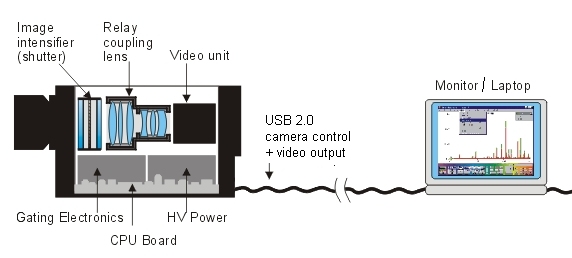Image intensified CCD high speed cameras

Since 1989, Stanford Computer Optics focus on image intensified high speed camera technology. Its outstanding combination of performance features makes the ICCD high speed camera type the most versatile workhorse amongst low light cameras. In addition, due to their picosecond gating capability our ICCD cameras are indispensable for high speed imaging applications in the area of ultrafast phenomena.
As shown in the picture above, an image intensified high speed camera basically consists of a high performance CCD camera and an image intensifier that is mounted in front of it. The incoming light is first amplified by the image intensifier. The intensified image is then transmitted from the intensifiers phosphor screen and projected onto the CCD sensor by means of a coupling lens.
Thus, an ICCD camera directly amplifies the incoming light, thereby supplying the CCD sensor with a light intensity far above the sensors thermal noise level. Compared to electron multiplying CCD cameras - EMCCD - image intensified cameras do not need strong cooling of the CCD sensor for this reason, thus avoiding condensation problems.
With our miniaturized "All-in-one-head" design the cameras only measure 110 x 135 x 248mm and weigh 3kg. This makes our ICCD camera type the smallest and most light weighted ultra high speed camera available on the market.
STANFORD COMPUTER OPTICS - Excellence is our passion
